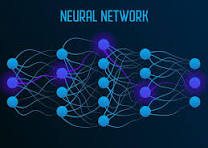Neural Networks
Structure of a Neural Network
-
Input Layer:
This is where the network receives data. Each neuron in this layer represents a feature in the dataset (e.g., pixels in an image or values in a spreadsheet). -
Hidden Layers:
These layers sit between the input and output layers. They perform calculations and learn patterns. The more hidden layers a network has, the deeper it is—hence the term deep learning. -
Output Layer:
This layer provides the final result, such as classifying an image or predicting a number.
How It Works
Each connection between neurons has a weight, and each neuron applies an activation function to decide whether to pass the signal forward. During training:
-
The network receives data (inputs).
-
It makes a prediction (outputs).
-
The prediction is compared to the actual answer using a loss function.
-
The error is reduced by adjusting the weights using a method called backpropagation and an optimization algorithm like gradient descent.
Applications
Neural networks are used in a wide range of fields:
-
Image and speech recognition
-
Natural language processing (NLP)
-
Autonomous vehicles
-
Medical diagnosis
-
Financial forecasting
-
Recommendation systems (like those used by Netflix or Amazon)
International Research Awards on Network Science and Graph Analytics
🔗 Nominate now! 👉 https://networkscience-conferences.researchw.com/award-nomination/?ecategory=Awards&rcategory=Awardee
🌐 Visit: networkscience-conferences.researchw.com/awards/
📩 Contact: networkquery@researchw.com
*****************
Tumblr: https://www.tumblr.com/emileyvaruni
Pinterest: https://in.pinterest.com/network_science_awards/
Blogger: https://networkscienceawards.blogspot.com/
Twitter: https://x.com/netgraph_awards
YouTube: https://www.youtube.com/@network_science_awards

Comments
Post a Comment